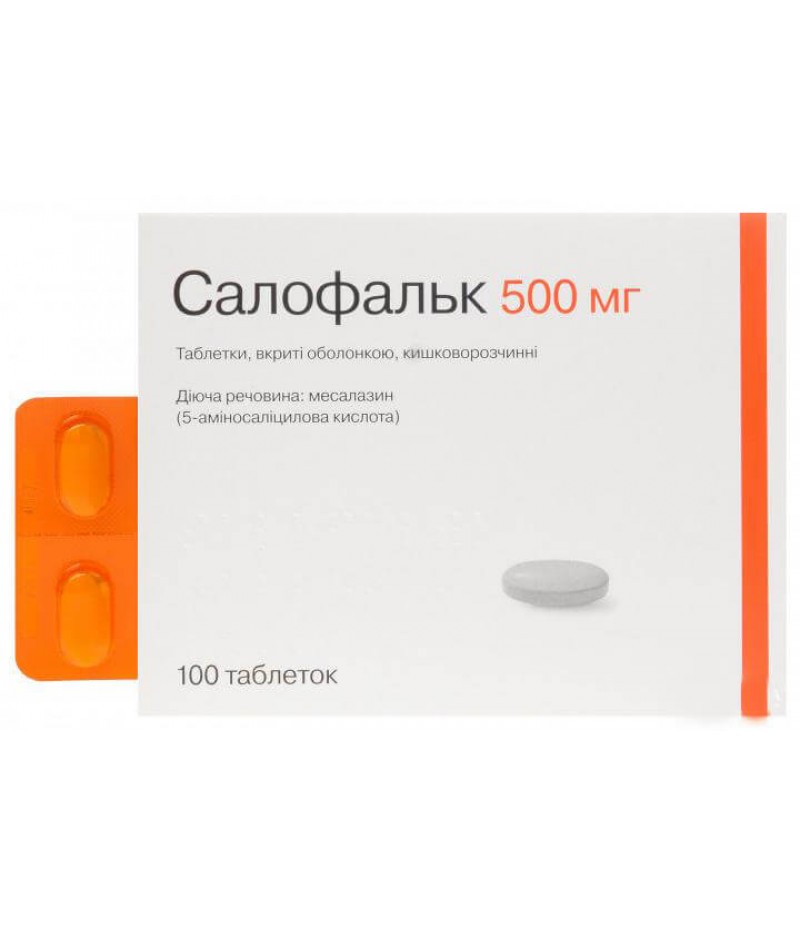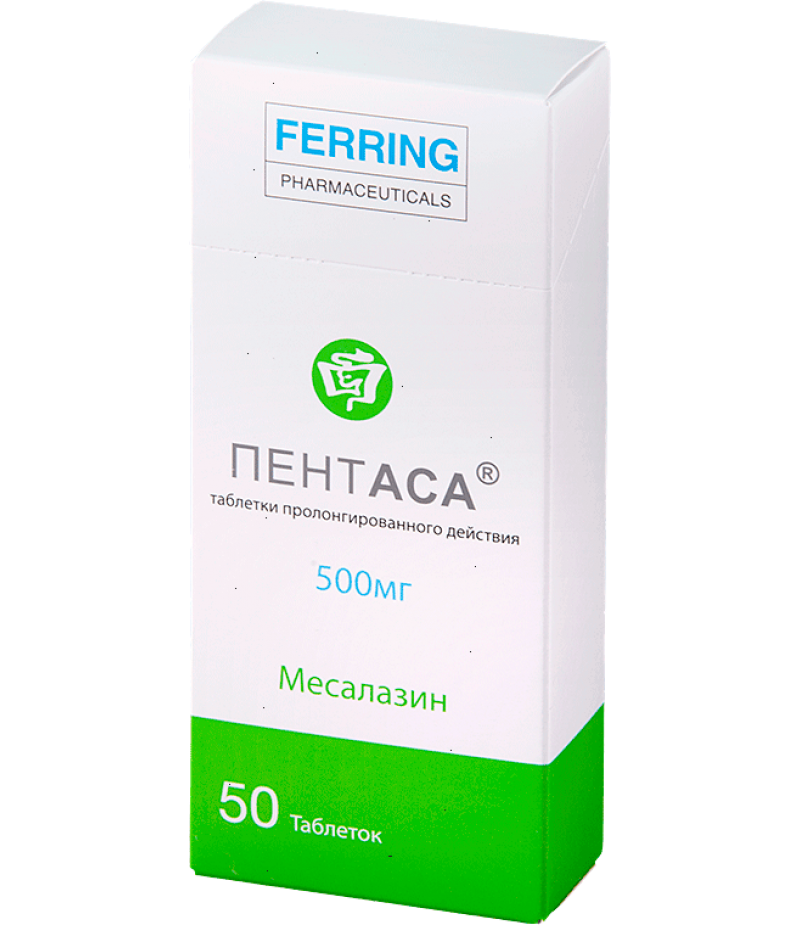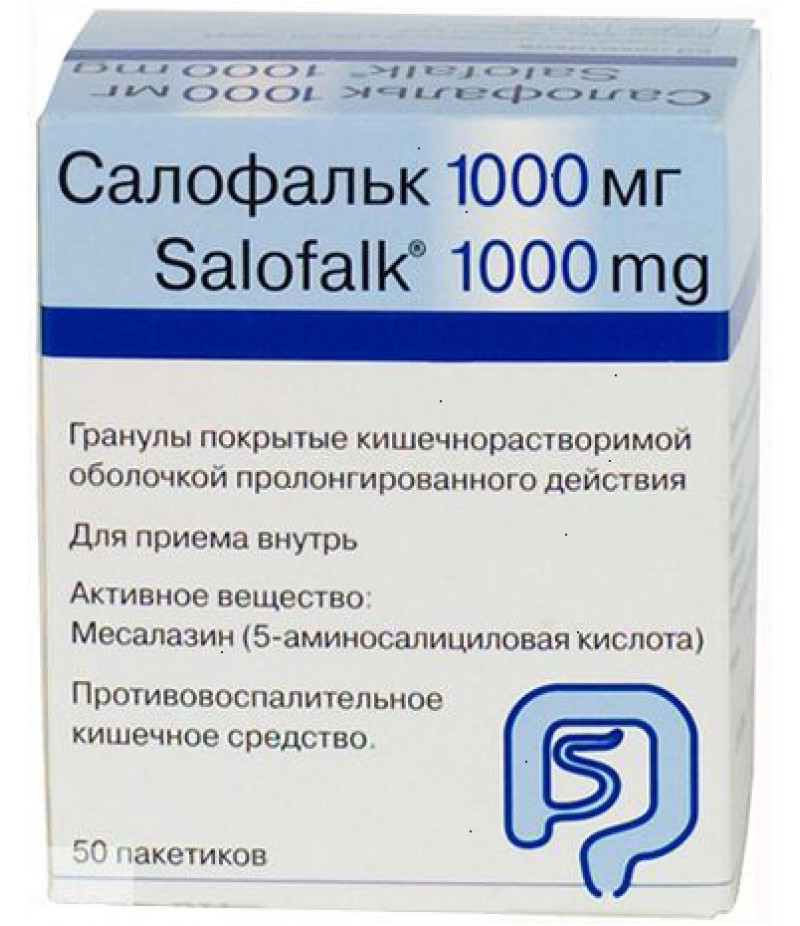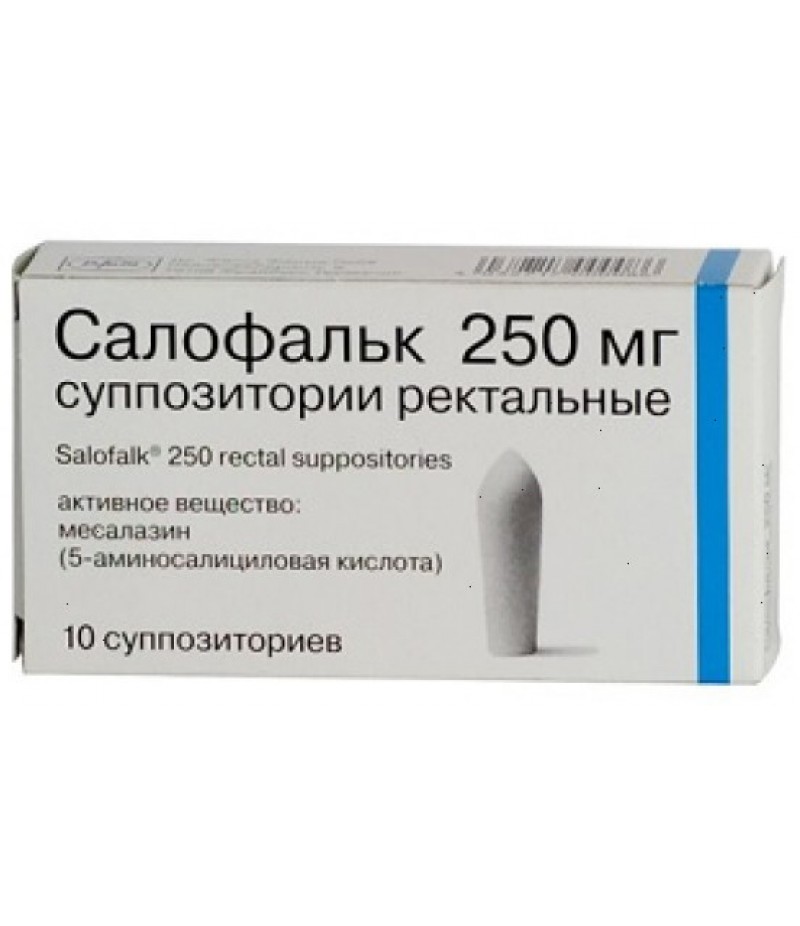Salofalk tabs 500mg #100
- $64.17
- 2 or more $63.50
- 3 or more $62.90
- Availability:In Stock
Salofalk tablets instructionYou can buy Salofalk tablets hereForm of release, composition and packagingTablets, covered with an enteric film membrane from light yellow to yellow-brown, oval, biconvex.1 tab.mesalazine (5-ASA) 500 m..
Tags: tabs
Salofalk tablets instruction
You can buy Salofalk tablets here
Form of release, composition and packaging
Tablets, covered with an enteric film membrane from light yellow to yellow-brown, oval, biconvex.
1 tab.
mesalazine (5-ASA) 500 mg
Auxiliary substances: sodium carbonate, glycine, povidone, microcrystalline cellulose, croscarmellose sodium, silicon colloidal dioxide, calcium stearate, hypromellose, methacrylic acid-methacrylate copolymer (1: 1), talc, titanium dioxide, iron oxide yellow oxide, macrogol, butyl methacrylate.
pharmachologic effect
Anti-inflammatory intestinal. Has a local anti-inflammatory effect due to inhibition of neutrophilic lipoxygenase and the synthesis of prostaglandins and leukotrienes. Slows migration, degranulation, phagocytosis of neutrophils, as well as secretion of immunoglobulins by lymphocytes. Has antioxidant effects (due to the ability to bind to free oxygen radicals and destroy them). Mesalazine can also trap radicals formed from reactive oxygen compounds. The results obtained in in vitro studies indicate the possible role of inhibition of lipoxygenase. The effect on the content of prostaglandins in the intestinal mucosa is also shown.
When administered orally, mesalazine exerts a predominantly local effect in the intestinal mucosa and submucosal layer, acting from the side of the intestinal lumen. Therefore, it is important that mesalasia is available in the area of inflammation. The ratio of systemic bioavailability and mesalazine concentration in plasma is not significant in terms of therapeutic effectiveness, but rather serves as a factor affecting safety.
The fact that Salofalk's granules are resistant to gastric juice and characterized by a pH-dependent (due to a coating in the form of Eudrajit L) and delayed (due to the matrix structure of granules) release of mesalazine helps to release the active ingredient at the right place.
Pharmacokinetics
Suction and distribution
The release of mesalazine occurs in the terminal section of the small and large intestine. Tablets begin to dissolve in the small intestine after 110-170 minutes and completely dissolve after 165-225 minutes after administration. The rate of dissolution is not affected by changes in the pH of the medium caused by ingestion of food or other drugs.
The release of mesalazine from the granules begins with a deceleration of 2-3 hours, Cmax in the plasma is reached after about 4-5 hours. Systemic bioavailability of mesalazine after oral administration is approximately 15-25%. Food intake slows down the absorption for 1-2 hours, but does not change the rate and degree of absorption.
Eating can slow the transit of the drug for 1-2 hours, while the Tlag values increase (the time gap after which the content of mesalazine is first determined in the blood) and Tmax, however, due to the small granule size, this does not change the rate and extent of absorption.
Eating causes a slight increase in Cmax and AUC.
The total amount of mesalazine and N-acetyl-5-aminosalicylic acid (N-Ac-5-ASA) excreted by the kidneys within 24 hours is equivalent to approximately 25-32%, respectively, of the prescribed dose of the pellets and Salofalk tablets. Approximately 30% of this amount is absorbed in the ileocecal zone, and approximately 90% in the whole in the ileocecal zone and the ascending colon. Thus, approximately 80-90% of the 5-ASA of the prescribed dose is present in the descending colon, sigmoid and rectum, where the rate of their absorption is low.
The values of serum Cmax 5-ASA and Ats-5-ASA in the equilibrium state were approximately 1.4 and 1.2 times higher after taking 1 time / day in comparison with the values observed when taking the drug 3 times / day in the same daily dose. Sss in the serum at the end of the dosing period when taking 1 time / day was only slightly lower than when taking 3 times / day (0.3 and 0.4 times for 5-ASA and Ac-5-ASA, respectively). When taking the drug 1 time / day, there were no signs of systemic cumulation.
Due to the size of the granules (about 1 mm), transit from the stomach to the small intestine occurs quickly. Combined pharmaco-cintigraphic and pharmacokinetic study showed that the drug reaches the ileocecal region after about 3 hours, and the ascending part of the colon approximately 4 hours later. The total transit time in the colon is about 20 hours. Approximately 80% of the oral dose taken reaches a thick, sigmoid and rectum.
The binding to plasma proteins of mesalazine and N-Ats-5-ASA is 43% and 78% (75-83%), respectively.
The mother's milk penetrates (in the form of a metabolite) 0.1% of the dose.
Metabolism
Mesalazine is metabolized both by the pre-systemic route in the intestinal mucosa, and systemically in the liver, turning into a pharmacologically inactive N-Ac-5-ASA. The nature of acetylation does not depend on the acetylating phenotype of the patient. To a small extent, acetylation can be carried out by the action of bacterial microflora of the colon.
Excretion
When mesalazine was given at a dose of 500 mg 3 times / day, the total elimination of mesalazine and N-Ats-5-ASA by the kidneys in saturation concentration was about 25%. The excretion of the unmetabolized portion of mesalazine was less than 1% of the orally administered dose. T1 / 2 in this study was 4.4 hours.
Pharmacokinetics in special clinical cases
With a single oral administration of Salofalk pellets at a dose of 20 mg / kg to 13 children with an active inflammatory disease of the large intestine (age from 5.9 to 15.8 years), the pharmacokinetics of systemic exposure of the drug corresponded to that of adults. Salofalk was safe and well tolerated.
Data on the pharmacokinetics of Salofalk in the elderly with its use, both in tablets and in granules are absent.
Indications
Pills
- Nonspecific ulcerative colitis (NNC);
- Crohn's disease (prevention, treatment of exacerbations).
Contraindications
- Blood diseases;
- Stomach ulcer and duodenal ulcer;
- hemorrhagic diathesis (with a tendency to bleeding);
- severe renal insufficiency;
Severe hepatic impairment;
- deficiency of glucose-6-phosphate dehydrogenase;
- phenylketonuria (for granules);
- Children under 3 years old (for tablets);
- Children under 6 years (for pellets);
- Hypersensitivity to the components of the drug and other derivatives of salicylic acid.
Caution should be given Salofalk with renal / hepatic insufficiency of mild and moderate severity, lung diseases (especially bronchial asthma), in the first trimester of pregnancy.
Dosage
Pills
The drug is prescribed by adults for 500 mg 3 times / day. In severe forms of the disease, the dose can be increased to 3-4 g / day for 8-12 weeks.
To prevent recurrence, the drug is prescribed 500 mg 3 times / day, if necessary - for several years.
Children with a body weight of up to 40 kg are prescribed a 1/2 day dose for adults - 250 mg three times a day (250 mg tablets should be used), children with a body weight of more than 40 kg should take 500 mg three times a day.
For the prevention of recurrence, the drug is prescribed 250 mg 3 times / day, if necessary - for several years.
Tablets should be taken whole, not liquid, after eating and drink with a lot of water. In distal forms of NNC, rectal administration of the drug in the form of suppositories rectal or rectal suspension is preferred.
Side effects of Salofalk tablets
Reactions associated with hypersensitivity: skin rash, itching, erythema, fever, bronchospasm, pericarditis, myocarditis, acute pancreatitis, interstitial nephritis, nephrotic syndrome. There were individual cases of allergic alveolitis and pancolitis. Under certain conditions, mesalazine and preparations having a similar chemical structure can lead to the development of a syndrome similar to that of systemic lupus erythematosus.
On the part of the digestive system: loss of appetite; rarely (<1/1000, but> 1/10 000) - diarrhea, nausea, abdominal pain, flatulence, vomiting; Very rarely (<1/10 000) - severe abdominal pain due to pancreatitis, severe diarrhea and abdominal pain due to allergic inflammation of the intestines, jaundice and abdominal pain due to bile secretion disorders, increased level of hepatic enzymes in the blood, hepatitis.
From the nervous system: rarely (1/10 000) - headache, dizziness; very rarely (<1/10 000) - peripheral neuropathy; possibly - depression, sleep disorders, malaise, paresthesia, convulsions, tremor, tinnitus.
From the cardiovascular system: it is possible - tachycardia, arterial hypertension or hypotension; Very rarely (<1/10 000) - chest pain, shortness of breath.
From the musculoskeletal system: very rarely (<1/10 000) - myalgia, arthralgia.
From the hemopoietic system: in some cases - anemia, leukopenia, agranulocytosis, thrombocytopenia.
From the coagulation system: in some cases - hypoprothrombinemia.
From the urinary system: in some cases - proteinuria, hematuria, crystalluria, oliguria, anuria.
Other: in some cases - reduced production of tear fluid; Very rarely (<1/10 000) - alopecia, fever, sore throat, reversible decrease in motility of spermatozoa.
Taking into account the chemical structure of the active substance, it is impossible to exclude the possibility of increasing the level of methaemoglobin.
If acute signs of intolerance arise, treatment should be stopped immediately.
Overdose
Symptoms: nausea, vomiting, gastralgia, weakness, drowsiness.
Treatment: gastric lavage, laxatives, symptomatic therapy. In cases of overdose, if necessary, an infusion of electrolyte capsules is performed (forced diuresis).
Drug Interactions
With the simultaneous use of Salofalk tablets causes an increase in the effect of anticoagulants of indirect action (increased risk of gastrointestinal bleeding).
With the simultaneous use of GCS with Salofalk, there may be an increase in undesirable reactions from the side of the gastric mucosa.
With the simultaneous use of Salofalk tablets increases the toxicity of methotrexate.
With the simultaneous use of probenecid and sulfinpyrazone with Salofalk tablets, a reduction in the excretion of uric acid is possible.
With the simultaneous use of Salofalk tablets reduces the diuretic effect of spironolactone and furosemide.
At simultaneous application with Salofalk tablets weakening of tuberculostatic action of rifampicin is possible.
With the simultaneous use of Salofalk tablets enhances the hypoglycemic effect of sulfonylurea derivatives.
When used simultaneously with lactulose or other drugs that lower the pH of the intestinal contents, it is possible to reduce the release of mesalazine from the granules due to a decrease in the pH due to the metabolism of the bacteria.
In patients who are simultaneously receiving treatment with azathioprine or 6-mercaptopurine, the possible increase in the myelosuppressive effect of azathioprine and 6-mercaptopurine should be borne in mind.
special instructions
Before the beginning of treatment, during, and after treatment, a general analysis of blood and urine is necessary.
Before and during the treatment, it is necessary to determine the parameters of the functional state of the liver (such as ALT or ACT activity) and monitor urinalysis (by dipping test strips). The control is recommended usually 14 days after the start of treatment, then 2-3 more times with an interval of 4 weeks. If the results of the tests are normal, control studies should be performed every 3 months. If additional symptoms appear, follow-up studies should be performed immediately.
Use with caution in patients with impaired liver function.
Purpose Salofalk tablets is not recommended for patients with severe renal dysfunction. If renal dysfunction has developed during treatment, one should think about the nephrotoxic effect of mesalazine. During the treatment should monitor the function of the kidneys.
When Salofalk tablets is prescribed to patients with lung diseases, in particular bronchial asthma, careful monitoring is necessary during the treatment.
Patients with a history of indication of adverse reactions when prescribing drugs containing sulfasalazine are subject to close monitoring during the initial period of treatment with Salofalk tablets. If Salofalk tablets treatment is associated with acute intolerance, such as convulsions, acute abdominal pain, fever, severe headache and rash, the drug should be discontinued immediately.
Patients who are "slow acetylators" have an increased risk of side effects.
There can be staining of urine and tears in a yellow-orange color, staining of soft contact lenses.
If multiple doses are missed, the patient should consult a doctor without discontinuing treatment.
When prescribing the drug for patients with phenylketonuria, it should be remembered that Salofalk tablets in the pellets contains aspartame in doses equivalent to the following amount of phenylalanine: 0.56 mg (Salofalk granules 500 mg), 1.12 mg (Salofalk granules 1 g).
Use in Pediatrics
Salofalk in granules should not be given to children under 6 years of age, since the experience of using the drug in patients of this age group is very limited.
Impact on the ability to drive vehicles and manage mechanisms
Care should be taken when driving a vehicle and engaging in potentially dangerous activities that require increased concentration and speed of the psychomotor reaction.
Pregnancy and lactemia
In the first trimester of pregnancy, the prescription of the drug is only possible on strict indications. If the course of the disease allows, in the last 2-4 weeks of pregnancy the drug should be stopped.
In the second and third trimesters, Salofalk tablets should be used only in cases where the potential benefit of therapy for the mother exceeds the possible risk to the fetus.
Salofalk in the form of granules can be used during breastfeeding only if the potential effect of its use on the mother exceeds the possible risk of adverse effects on the child. If a newborn breastfed has diarrhea, breastfeeding should be discontinued.
If it is necessary to appoint Salofalk tablets in the form of tablets during lactation, breastfeeding should be discontinued.
Before the planned pregnancy, it is recommended, if possible, to stop Salofalk tablets treatment or to apply the drug in reduced doses.
Application in childhood
The drug is contraindicated in children under the age of 3 years.
Children with a body weight of up to 40 kg are prescribed a 1/2 day dose for adults - 250 mg 3 times / day, children with a body weight of more than 40 kg - 500 mg 3 times / day.
For the prevention of recurrence, the drug is prescribed 250 mg 3 times / day, if necessary - for several years.
In case of violations of kidney function
The drug is contraindicated in severe impairment of kidney function.
With violations of liver function
The drug is contraindicated in severe violations of liver function.
Conditions of leave from pharmacies
To buy Salofalk tablets you don't need a prescription.
Terms and conditions of storage
The drug should be stored in a dry, protected from light, out of reach of children at a temperature of no higher than 25 ° C. Shelf life of the tablets is 3 years, granules - 4 years.




